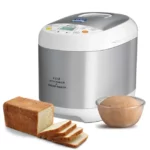
Kent Wood Heaters
COVERS MODELS
JINDABYNE (STD FIRE BOX)
COUNTRY CLASSIC (STD FIRE BOX)
SOMERSET (SLIM LINE FIRE BOX)
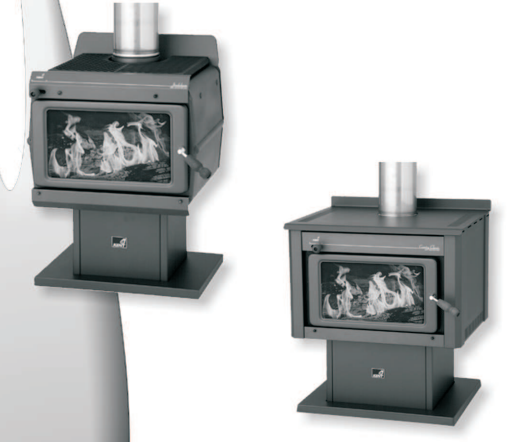
Tested and approved to Australian Standards AS/NZS 2918 and AS/NZS 4013/4012.
Prior to installation check with your state and local authorities regarding any specific regulations that may apply.
Please keep these instructions for future reference.
Burn hardwood only.
FIRST THINGS FIRST…
Congratulations on your purchase of a quality Kent wood heater. This product is designed according to strict environmental, quality and safety standards and should give you years of trouble free home heating.
Read these instructions carefully to get the most out of your heater and to ensure safe and satisfactory heater performance. In particular, we would like to draw your attention to these warnings.
Be careful of what you burn:
- Use only dry, well seasoned hardwood.
- Do not use coal or briquettes.
- WARNING: DO NOT USE FLAMMABLE LIQUIDS OR AEROSOLS TO START OR REKINDLE THE FIRE.
- Do not burn garbage in the firebox as garbage can cause a dangerous soot build up and increase the amount of smoke your heater produces.
- Do not burn chemically treated timber as the poisonous gases given off could damage your stove.
- CAUTION: THE USE OF SOME TYPES OF PRESERVATIVE-TREATED WOOD AS FUEL CAN BE HAZARDOUS.
- Do not place any types of builders board eg fibro, cement sheeting (or any other materials not specified and tested by the manufacturer) inside the firebox.
Protect yourself and your family from burns:
- WARNING: OPEN AIR CONTROL BEFORE OPENING FIRING DOOR.
- The exterior surfaces of the heater will become hot during operation. For protection of children, the elderly or infirm, provide a firescreen to prevent contact with the appliance in operation.
- To protect against injury from burns, use caution when operating the appliance. In particular, when loading the firebox, provide adequate protection for your hands.
Use your heater according to these instructions:
- CAUTION: THIS APPLIANCE SHOULD BE MAINTAINED AND OPERATED AT ALL TIMES IN ACCORDANCE WITH THESE INSTRUCTIONS.
- DO NOT BURN WITH DOOR OPEN.
- CAUTION: THIS APPLIANCE SHOULD NOT BE OPERATED WITH A CRACKED GLASS.
- Do not throw logs into the firebox. Always place logs carefully.
- Load logs with ends pointing to the front of the heater. This will help prevent logs rolling forward.
- Do not overfire (allow firebox to glow red) as this could damage your firebox.
- Always leave a minimum of 25mm (1) of ash in the bottom of the firebox. Never empty it completely.
- WARNING: ANY MODIFICATION OF THE APPLIANCE THAT HAS NOT BEEN APPROVED IN WRITING BY THE TESTING AUTHORITY IS CONSIDERED AS BREACHING AS/NZS 4013.
- The appliance or flue system should not be modified in any way without the written approval of the manufacturer.
The heater can get very hot, so watch obvious fire hazards:
- Do not place clothing or other combustible materials on top of the heater.
- WARNING: DO NOT USE FLAMMABLE LIQUIDS OR AEROSOLS OR PLACE THESE IN THE VICINITY OF THIS APPLIANCE WHEN IT IS OPERATING.
- WARNING: DO NOT STORE FUEL WITHIN HEATER INSTALLATION CLEARANCES.
- Do not store flammable liquids near the heater.
- Do not store fuel close to the stove.
Exclusion of Liability
Whilst every care has been taken in formulating these instructions, no responsibility whatsoever will attach to and/or claim lie against, the manufacturer and/or the distributor of the heater as a result of any failure to follow the whole or any part of the instructions and/or as a result of incorrect information herein and/or any omission here from.
ASSEMBLING YOUR NEW HEATER
There are a number of heaters in the Kent range. The heaters are mounted on columns, which require some assembly. Convection models are supplied with fans, which will need to be assembled. All heaters will require firebrick and baffle plate assembly.
Column Assembly
There are a few different column styles. Some do not require screws: you assemble the column by inserting the tags located at either end of the front and rear panels. Push the front and rear panels down to lock tags into position. The column can be further secured if you wish by fitting self tapping screws into the holes provided between the tags (screws not provided).
Other side panels have nuts and screws provided for you to screw the panels together.
If your heater comes with a fan, the side panels will have two holes at the top for securing the fan. These must face the rear of the firebox.
Next, fit the aluminium heatshield to the top of the column, ensuring the shield locates in the slots at the top of the column. 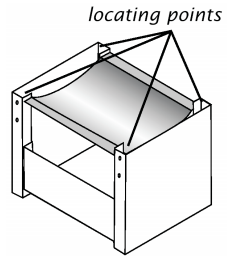
You must now attach the firebox. Lay the firebox on its back. Locate the column onto the four locating points on the base of the heater. Ensure the side of the column with a 45 mm gap on the bottom edge goes at the rear of the heater.
Secure the column to the base of the heater with the four self tapping screws provided.
Now stand the heater and column assembly up and place into the base.
Deflector & Heat Shield
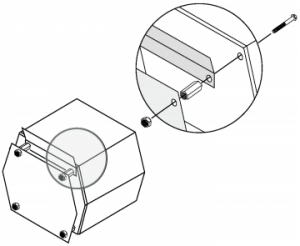
Fan Assembly
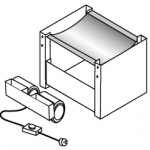
The earth wires on the fan will need to be fixed to the column. Refer to detail view below.
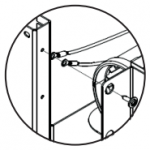
Firebricks (Standard Firebox)
Standard sized fireboxes use 7 firebricks and a ceramic base liner in the arrangement shown below.
Place the base liner down so that it is flush against the front of the firebox. Place two firebricks on each side laying down. Place three firebricks at the back standing upright.
Now place the brick retainer along the back firebricks so that the lip hangs over the front of the bricks.
If necessary, push the side bricks towards the back of the heater so they sit against the brick retainer. This arrangement prevents the back bricks from falling forward.

Firebricks (Slimline Firebox)
Slimline fireboxes use 6 firebricks and a ceramic base liner in the arrangement shown below.
Place the base liner down so that it is flush against the front of the firebox. Place two firebricks on each side standing upright. Place two firebricks at the back laying down sideways.
Now place the brick retainer along the back firebricks so that the lip hangs over the front of the bricks.
If necessary, push the side bricks towards the back of the heater so they sit against the brick retainer. This arrangement prevents the back bricks from falling forward.
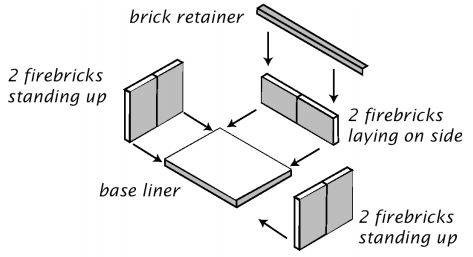
All Models – Baffle Plate
The baffle plate MUST be installed prior to operating the appliance. Ensure that the baffle plate is pointing forward.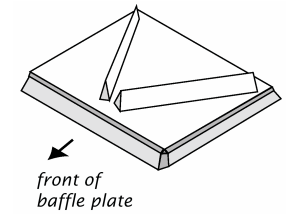
The left side of the plate should be directed over the plate bracket and pushed against the top left edge of the firebox. The right hand side should then be lifted up over the right hand bracket. The plate can now be allowed to rest into position. Ensure the plate is sitting evenly on both brackets, and is pushed all the way to the back of the heater.
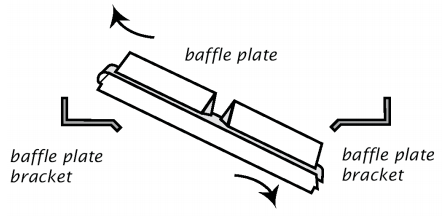
Kick Plate
(For Jindabyne only) To assemble the kick plate, use the two short locating screws provided.
Insert the screws from the inside of the firebox and then screw the spacer to the front, as shown in the diagram below. Use the spacers with the threaded tip.
Now, place the kick plate against the spacers and secure with the two dome nuts provided.
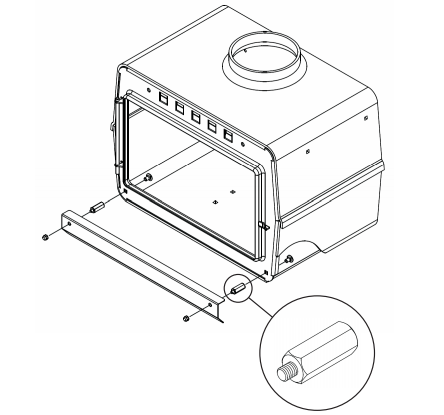
INSTALLATION – GENERAL NOTES
Before Beginning
Before beginning the installation of your wood heater, you should note the following precautions:
* WARNING: THE APPLIANCE AND FLUE-SYSTEM SHALL BE INSTALLED IN ACCORDANCE WITH AS/NZS 2918 AND THE APPROPRIATE REQUIREMENTS OF THE RELEVANT BUILDING CODE OR CODES.
* WARNING: APPLIANCES INSTALLED IN ACCORDANCE WITH THIS STANDARD S H A L L C O M P L Y W I T H T H E REQUIREMENTS OF AS/NZS 4013 W H E R E R E Q U I R E D B Y T H E REGULATORY AUTHORITY I.E. THE APPLIANCE SHALL BE IDENTIFIABLE BY A COMPLIANCE PLATE WITH THE MARKING ‘TESTED TO AS/NZS 4013.
* WARNING: ANY MODIFICATION OF THE APPLIANCE THAT HAS NOT BEEN APPROVED IN WRITING BY THE TESTING AUTHORITY IS CONSIDERED TO BE IN BREACH OF THE APPROVAL GRANTED FOR COMPLIANCE WITH AS/NZS 4013.
* CAUTION: CRACKED AND BROKEN COMPONENTS, e.g. GLASS PANELS OR CERAMIC TILES, MAY RENDER THE INSTALLATION UNSAFE.
* It is strongly recommended that a certified/qualified installer perform the installation.
* You may need to get council approval prior to installation.
* You should also check with your insurer for any requirements they may have.
Flue Installation
The correct flue system is critical to the performance of your wood heater. It must either be tested with the heater or be a default flue kit.
We recommend you use a Maxiheat Default Flue Kit.
CAUTION: MIXING OF APPLIANCE OR FLUE-SYSTEM COMPONENTS FROM DIFFERENT SOURCES OR MODIFYING TH E DIMENSIONAL SPECIFICATION OF COMPONENTS MAY RESULT IN HAZARDOUS CONDITIONS. WHERE SUCH ACTION IS CONSIDERED, THE MANUFACTURER SHOULD BE CONSULTED IN THE FIRST INSTANCE.
Flue Height Requirements
Your flue must extend the required height above your roof to promote sufficient draught. If the flue is not high enough, the heater will not draw properly causing smoke to spill back into the room.
The minimum height of the active flue must be 4.6m in length measured from the hearth plate to the flue termination point. The flue must extend at least 1m out of the roof. The flue must clear any ridge or obstruction within a 3m radius by a minimum of 1m.
For very steep roofs (45° or steeper) it is often impractical to get above the highest point. The use of an anti-downdraft cowl is advisable.
On flat roofs, the flue must extend a minimum of 1.5m.
There are other variables that can affect draught (eg trees or tall buildings nearby). If you have the correct flue height and still have problems, consult your dealer.
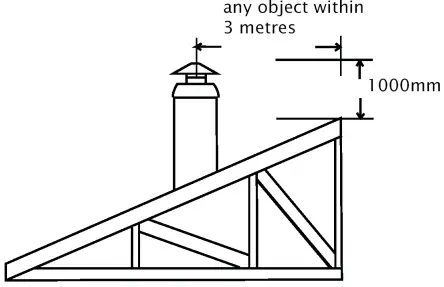
Location
Select a location for your wood heater with great care.
- Do not place your heater in areas of high traffic, near furniture or draperies.
- Check that the intended location will not interfere with ceiling joists, rafters, valleys and ridges.
Hearth Requirements
If your wood heater is to be installed on carpet, timber or any other combustible material, you must place a hearth (also known as a floor protector) underneath the heater. Please observe the following:
- The hearth must consist of at least 17 mm of noncombustible material
- It is not recommended that you make your own hearth
- The hearth and heater assembly must be placed on a firm and level surface.
Hearth Clearances
It is necessary to ensure that the heater is positioned on the hearth so that the requirements stated on the separate enclosed sheet or the back of the heater are observed. The diagrams show the distance by which the front of the hearth and the sides of the hearth should extend past the heater door.
Heater Clearances
It is vital that the heater be installed the proper distance from combustible surfaces like wood, gyprock and curtains. These minimum distances which you need to observe for your particular heater are stated on the separate enclosed sheet or the back of your heater. The diagrams show both parallel and corner installations.
Failure to maintain these minimum distances may result in a fire for which your insurer may refuse to cover.
Reduced Clearances
These clearances can be reduced with proper heat shielding. Basically a noncombustible surface is placed between the heater and the combustible wall. It is vital that an unobstructed air flow be maintained between the two surfaces to remove excess heat.
WOOD SELECTION
Few things affect the performance of your heater as much as the fuel you burn. Take note of the following:
What Not To Burn
- Softwood (except kindling)
- Wet or unseasoned wood
- Treated or painted timber
- Saltwater wood
- Coal or charcoal
- Garbage, plastic etc
- Any solvents, kerosene, petrol or any flammable liquid.
What To Burn
Quite simply, dry seasoned hardwood.
From when wood is first cut down, it takes up to 12 months of dry storage for the wood to season properly. The seasoning process is underway when cracks begin to appear at the ends of cut timber.
Use of moist or unseasoned wood will result in excessive smoke, longer startup times, a lazy flame that requires more air to stay alight, creosote build up in the flue and on the door glass, and a much less powerful fire. The reason is simple. Heat that would normally be going into the room is wasted boiling water that is trapped inside the wood. This poor performance costs you money in wasted fuel and increased maintenance.
It is difficult to determine if wood is dry just by looking at it. If you can hear the wood sizzle and hiss, or can see moisture bubbling from the wood surface, then your wood is too wet. In practice, the best thing you can do is to be sure of the source. Buy your wood from reputable wood merchants. Make sure you store the wood correctly.
Wood Storage
It is important that wood be stored under cover. Even wood that is years old will absorb large quantities of moisture if exposed to the elements.
It is advisable that wood is stacked to allow some air flow in and around the logs. This will help keep the wood dry.
Wood Splitting
It is best to have on hand a good range of wood sizes to help control the fire. The rule of thumb is: the hotter the fire, the bigger the log you can put in.
- You need very small pieces of kindling to get the fire started efficiently.
- Small pieces up to about 50mm thick are good when the fire is still being established, or when you want to revive a fire that has burnt low.
- Larger logs are excellent for long burns once the fire is well established.
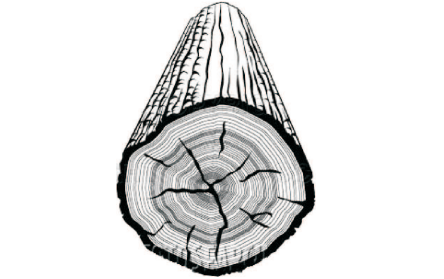
USING YOUR HEATER
Before using your wood heater, study this entire section carefully. It will assist you in achieving maximum efficiency and enjoyment.
Curing the Paint
Various parts of your heater have been coated with high quality paints to protect them and to give them an attractive finish. You will need to break-in your heater to harden or cure these coatings.
While curing, be careful not to touch the painted surfaces as the paint will be quite soft.
The basic rule is: cure slowly, over about three burns, without a hot fire. During the curing process it is normal for some smoke and smell to be given off from the surface of the heater. Each time, some windows should be opened to allow the paint odours to escape. Using a fan also helps disperse the odours. For this reason it is best done during the day.
- The first fire should be kindling only and should last for about 20 minutes. Leave the door slightly ajar to stop the door rope from sticking.
- Once the heater has cooled down, repeat the process.
- The third fire should be a normal fire of at least 45 minutes.
By this time, your heater should be cured. In colder conditions, or if the heater uses a fan, it may take slightly longer. The house should be ventilated until all odours are gone.
Operating The Air Control
You can control whether your heater burns on high or low with the air control lever found on the front of the heater. The high and low positions are clearly marked on all models.
For low burns – Use this setting for low burning, or for extended burn times.
For medium burns – This is the optimal setting for normal use.
For high burns – Use this setting for starting the fire and for at least 30 minutes after loading and reloading.
Lighting The Fire
Wood burns most efficiently when placed in a very hot fire. These procedures are designed to bring your firebox to the right temperature as quickly as possible.
Put the air control on high.
Place a large amount of kindling in a criss-cross pattern over a firelighter. Make sure plenty of air can get into the stack and around each piece of kindling.
Add a few small pieces of wood on top. The firebox should be about half full of fuel.
Ignite the firelighter.
Continue to add small pieces of wood until a bed of hot glowing coals is established.
Place two or three thoroughly dry split logs (about 80-100mm diameter) on the well established fire. Logs will burn better if they are placed with their ends near the glass, ie front to back.
Leave the air control on high for about 30 minutes. After this time, the firebox should be hot enough for normal operation, so you can turn down to medium or low.
Adding fresh wood cools the fire down, so when you need to replenish the fuel, turn the air control to high for about 30 minutes to bring the firebox temperatures back up to normal
Always leave the air control on high for at least 30 minutes after reloading.
A Few Hints
Wood should be stacked front to back – with the ends facing the door – and with space between them for air to flow around.
The door should remain closed at all times except when first establishing the fire and when loading.
There are many factors that can affect the way your heater burns, including flue height, wood type, shape, amount, the way it is stacked, wind conditions and outside air temperatures to name a few. You will find that before long you will get to know how your heater works best for you.
Overnight Burns
Large unsplit logs are the best fuel to use.
Make sure you have a good strong bed of glowing coals and the heater is hot before loading the logs.
Place a load of wood on the strong base fire and coals, shut the door and leave on high for about 30 minutes or until the logs are charred all over.
Turn down to low.
Restarting After an Overnight Burn
Adjust air control to high.
Rake the hot coals.
Place some kindling and small logs on the coals.
Once the fire is established, start putting on larger logs.
Removing Ashes
When the ashes are level with the firebox opening, it s time for a clean out. This should only be done when the firebox has completely cooled. Removing hot ashes is hazardous.
Push chunks of charred wood to one side. These will burn in the next fire, so it would be a shame to waste them. Using a metal scoop, remove excess ash and place in a metal container.
You should leave a small amount of ash in the firebox to provide an insulating base for the next fire. Rake them over so they form a flat bed.
When disposing of the ashes, keep them in a metal or other non-combustible container with a tight fitting lid. Move them outdoors immediately to an area clear of combustible materials. Do not place them in plastic receptacles.
Heaters With Fans
If your heater is fitted with a fan, the fan should only be used on high or boost when the air control is on the maximum setting.
The fan should never be used when the air setting is on low or overnight setting.
We also recommend not using the fan until 30 minutes after the fire is first lit.
CARE AND MAINTENANCE
Your heater has been designed as a heavy duty appliance capable of withstanding normal operating conditions.
Care
The firebox liners where fitted must be treated with care. Avoid throwing logs into the firebox as this may fracture the liners.
Cleaning
Painted surfaces: to clean painted surfaces, wipe over with a soft, damp cloth. Do not use harsh solvents and cleaning agents as these can damage the coating. Buff dry with a soft, dry cloth.
If your heater is installed in a coastal environment, where salt air will come in contact with the heater, this cleaning process should be performed weekly to avoid the salt causing deterioration of the paint and subsequently rust.
Door glass: sometimes black deposits will build up on the inside of the door glass. To remove this build up, rub gently with a plastic scourer pad moistened with water and detergent. Then use the damp and dry cloths as before. Hot glass cleaner is also available from your heater retailer.
Routine Maintenance Schedule
At beginning of the season and at least every 8 weeks during the season
- Inspect and clean the flue system. To do this, remove the baffle plate and flue cowl, and clean out with a flue brush.
- Check the painted surfaces. If there is any wear, for instance from cleaning or abrasion, touch up paint is available from your dealer.
At end of season
- Inspect the door glass for any cracks and replace if necessary.
- Inspect door rope and seals and replace if necessary.
- Inspect firebox for wear or excessive corrosion.
- Inspect firebricks where fitted and replace if broken.
- Check that the air slide moves smoothly. If it is sticky, lubricate it with high temperature grease available from your local hardware store.
Creosote Build Up
When the heater is continually burnt with lower than normal fire temperatures, eg due to unseasoned wood, higher than acceptable amounts of smoke are produced which condense on the inside of the flue. This builds up as a black, tar-like deposit called creosote.
A thin layer of creosote inside the flue is normal and will not cause a problem. Once there is a layer more than 3mm thick, problems can occur.
- If the layer is thick enough, it restricts the flue and can cause insufficient draw and even smoke spillage back into the house.
- More seriously, creosote is combustible, and can ignite. A flue fire is easy to detect, involving a roaring sound, a vibration of the flue, and sometimes flames and sparks shoot out of the top of the flue.
To avoid creosote build up and the fires that may result, burn seasoned wood with the air control set to medium or high for most of the time.
To remove creosote when it does build up, remove the baffle plate and flue cowl, and use a flue brush to clean the flue system. To remove the baffle plate, slide the plate up on one side and then down around the brackets on the other.
In case of a flue fire, do not panic. Your flue system has been constructed to withstand high temperatures. Immediately close the air control down to its lowest setting. Do not open the door. Once the fire has extinguished, you should have your flue system inspected by a qualified service person.
CARING FOR THE ENVIRONMENT
Caring for our planet means reducing pollution and managing our resources intelligently. Every resource we use today we are borrowing from our future generations.
The key to successfully meeting our future energy requirements lies in our ability to manage existing resources wisely. Unlike fossil fuels such as oil, coal and gas, wood can be managed on a sustainable basis.
This is why wood is one of the wisest, most cost effective and environmentally efficient forms of home heating available today.
You can make a further positive contribution to the environment by following these important steps:-
Operating Your Heater
- Always burn good, dry hardwood. This will yield the greatest amount of heat for the least amount of fuel.
- Never burn green or unseasoned wood, or wood that is wet. This will waste energy, cause excessive smoke and reduce the performance of your wood heater.
- Do not allow your wood to smoulder. Your fire should always burn brightly and cleanly. Check the flue occasionally to see if there is any excessive smoke.
Other Things You Can Do
- Ensure your home is adequately insulated. This will reduce your energy requirements, and lessen your fuel bills, or the need to gather fuel. This in turn reduces pollution.
- Do not overheat your home! If you feel hot even when wearing light clothing, then you are wasting energy.
- Install ceiling fans in the main rooms. These are an excellent investment in year round comfort. Because hot air rises, ceiling fans push this hot air back closer to ground level to keep you warmer.
Landcare
A portion of the sale of your heater is donated directly to Landcare by the Australian Home Heating Association.
Landcare is one of the most proactive community based environmental groups in Australia today. Almost 5000 Landcare groups have sprouted across Australia and like the millions of trees Landcare has planted, they’re still growing. One of three farmers is a member of Landcare.
These groups get involved in activities like tree planting and revegetation, weed removal, fencing, feral animal control, water quality monitoring, nature surveys, riverbank repair, and sustainable agricultural techniques.
Landcare groups are usually formed because there is a problem. Locals notice changes in their environment and decide to do something about it. Landcare groups can grow out of neighbouring farms, or neighbours in the city that share a local park. Landcare groups are working on all imaginable ecosystems in Australia, from dry and dusty central Australia, to tropical rainforests of Queensland and the mountains in Tasmania.
